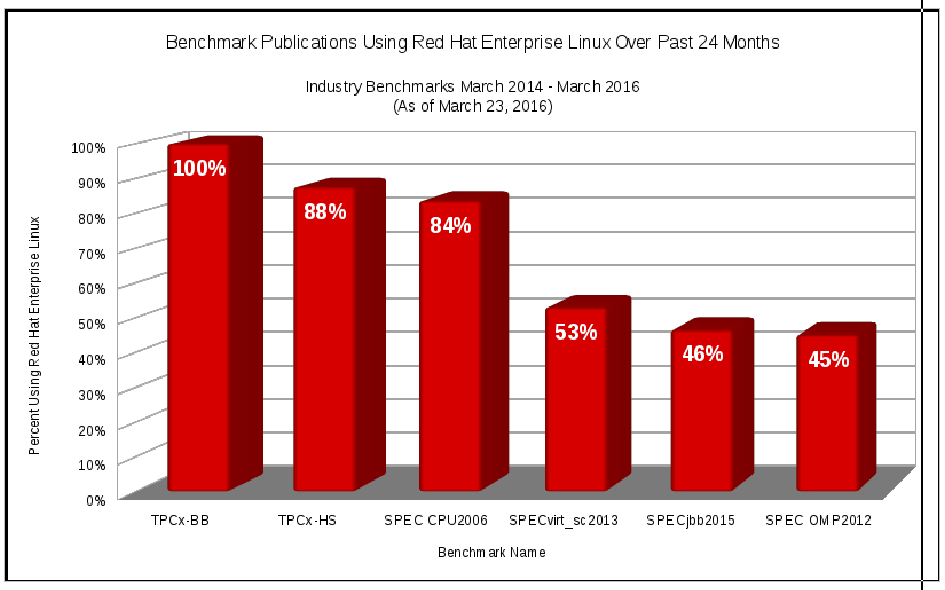Yesterday, Intel launched the Xeon E5-2600 v4 processor family with 26 new world records on industry-standard benchmarks. Once again, Intel’s innovation, driven by Moore’s law, has enabled faster computing for the enterprise world.
Red Hat and Intel have enjoyed a long history of collaboration across a full spectrum of enterprise IT - covering a wide range of use cases, from applications running on physical servers to virtualized and cloud-based deployments. It should come as no surprise that many of
these benchmark results were announced with Red Hat Enterprise Linux serving as the underlying platform (see table below).
| Significance | OEM Platform | Benchmark | OS |
| 2-socket world record (tie) | Cisco UCS C220 M4 | General Server Throughput Computing: SPECint_rate_base2006 | Red Hat Enterprise Linux 7 |
| 2-socket world record (tie) | Fujitsu PRIMERGY RX2540 M2 | General Server Throughput Computing: SPECint_rate_base2006 | Red Hat Enterprise Linux 7 |
| 2-socket world record (tie) | Huawei RH2288H v3 | General Server Throughput Computing: SPECint_rate_base2006 | Red Hat Enterprise Linux 7 |
| 2-socket world record | Cisco UCS C220 M4 | General Server Speed Computing: SPECint_base2006 | Red Hat Enterprise Linux 7 |
| 2-socket world record (tie) | Cisco UCS C220 M4 | Technical Speed Computing: SPECfp_base2006 | Red Hat Enterprise Linux 7 |
| 2-socket world record | Cisco UCS B200 M4 Blade Server | Technical Computing: SPECompG_base2012 | Red Hat Enterprise Linux 6 |
| 2-socket world record | Cisco UCS C220 M4 | Server-side Java: SPECjbb*2015 Multi-JVM Critical-jOPS | Red Hat Enterprise Linux 7 |
| 2-socket world record (Linux) | Dell PowerEdge R730 | Business Processing - Enterprise Resource Planning (ERP): Two-tier SAP Sales and Distribution | Red Hat Enterprise Linux 7 |
| World record | HPE ProLiant DL380 Gen9 | Big Data Analytics: TPC Benchmark Express Big Bench @ 3000 | Red Hat Enterprise Linux 6 |
| World record | HPE ProLiant DL380 Gen9 | Server-side Java: SPECjbb2015 Distributed Max-jOPS | Red Hat Enterprise Linux 7 |
| World record | HPE ProLiant DL360 Gen9 | Server-side Java: SPECjbb2015 Distributed Critical-jOPS | Red Hat Enterprise Linux 7 |
| World record | HPE ProLiant ML350 Gen9 | Server-side Java: SPECjbb2015 Composite Max-jOPS | Red Hat Enterprise Linux 7 |
| World record | HPE ProLiant DL360 Gen9 | Server-side Java: SPECjbb2015 Composite Critical-jOPS | Red Hat Enterprise Linux 7 |
| 2-socket x86 world record | HPE ProLiant DL360 Gen9 | Server-side Java: SPECjbb2015 Multi-JVM Max-jOPS | Red Hat Enterprise Linux 7 |
| 2-socket x86 world record | Lenovo System x3650 M5 | Infrastructure/Virtualization: SPECvirt_sc2013 | Red Hat Enterprise Linux 7 |
| World record | Lenovo System x3650 M5 | Infrastructure/Virtualization: SPECvirt_sc2013 PPW (Server and Storage Performance per Watt) | Red Hat Enterprise Linux 7 |
| World record | Lenovo System x3650 M5 | Infrastructure/Virtualization: SPECvirt_sc2013 ServerPPW (Server Performance per Watt) | Red Hat Enterprise Linux 7 |
Source: http://www.intel.com/content/www/us/en/benchmarks/server/xeon-e5-v4/xeon-e5-v4-world-record.html
With 17 world record results on the Intel Xeon E5-2600 v4 processor family, Red Hat Enterprise Linux was a platform of choice for several Original Equipment Manufacturers (OEMs), just as it was for the Intel Xeon E5-2600 v2 and Xeon E5-2600 v3 families of processors at their respective launches.
For our customers, these results position Red Hat Enterprise Linux as an excellent choice for demanding enterprise workloads running across, physical, virtual or cloud deployments, thanks in no small part to Red Hat Enterprise Linux’s system performance and support for many of the latest enterprise computing features. These results demonstrate that Red Hat Enterprise Linux runs workloads more efficiently with fewer systems while achieving better results as compared to the competition.
We would like to congratulate our OEM partners that have selected the world’s leading enterprise Linux platform to deliver these top performance results on new hardware. These outstanding results underscore the importance of collaboration across the entire technology ecosystem, as many of these records are the culmination of combined silicon, hardware and software improvements.
We are very pleased to see a continued dedication to Red Hat Enterprise Linux as an open source platform for handling the rigors of these very demanding benchmarks. Compared to other operating systems used to produce record-setting results, Red Hat Enterprise Linux was used in one half of all publications. Out of 34 benchmark results results posted by 9 different OEM partners, Red Hat Enterprise Linux was used in 17, surpassing both SuSE and Microsoft.
Moreover, the industry adoption of Red Hat Enterprise Linux for running and publishing standard benchmarks, such as those from SPEC and TPC, continues to grow.
As the chart (above) demonstrates, Red Hat Enterprise Linux was predominantly used in TPC and SPEC benchmark publications during the last two years*. These benchmarks cover a broad spectrum of workloads ranging from compute-intensive technical computing problems to Big Data analytics and from enterprise Java applications to virtualization.
Enterprises and customers place increasing demands on their infrastructure and, with today’s results and those before it, Red Hat’s flagship platform continues to distinguish itself by showing industry-leading capabilities and excellent performance regardless of workload type and deployment environment, effectively expanding the boundaries of traditional IT.
All results as of March 31, 2016. SPEC and the benchmark names SPEC CPU, SPECjbb, SPEComp and SPECvirt_sc are registered trademarks of the Standard Performance Evaluation Corporation. For more information about SPEC and its benchmarks see: www.spec.org. TPC is a trademark of the Transaction Processing Performance Council (TPC). For more information about the TPC and it's benchmarks see www.tpc.org. SAP and SAP NetWeaver are the registered trademarks of SAP AG in Germany and in several other countries. See www.sap.com/benchmark for more information.
* Results as of March 23, 2016. Based on the data collected for two calendar years (from 03/2014 to 03/2016) using the following public resources: http://www.spec.org and http://www.tpc.org/
저자 소개
Yan Fisher is a Global evangelist at Red Hat where he extends his expertise in enterprise computing to emerging areas that Red Hat is exploring.
Fisher has a deep background in systems design and architecture. He has spent the past 20 years of his career working in the computer and telecommunication industries where he tackled as diverse areas as sales and operations to systems performance and benchmarking.
Having an eye for innovative approaches, Fisher is closely tracking partners' emerging technology strategies as well as customer perspectives on several nascent topics such as performance-sensitive workloads and accelerators, hardware innovation and alternative architectures, and, exascale and edge computing.
채널별 검색
오토메이션
기술, 팀, 환경을 포괄하는 자동화 플랫폼에 대한 최신 정보
인공지능
고객이 어디서나 AI 워크로드를 실행할 수 있도록 지원하는 플랫폼 업데이트
클라우드 서비스
관리형 클라우드 서비스 포트폴리오에 대해 더 보기
보안
환경과 기술 전반에 걸쳐 리스크를 감소하는 방법에 대한 최신 정보
엣지 컴퓨팅
엣지에서의 운영을 단순화하는 플랫폼 업데이트
인프라
세계적으로 인정받은 기업용 Linux 플랫폼에 대한 최신 정보
애플리케이션
복잡한 애플리케이션에 대한 솔루션 더 보기
오리지널 쇼
엔터프라이즈 기술 분야의 제작자와 리더가 전하는 흥미로운 스토리
제품
- Red Hat Enterprise Linux
- Red Hat OpenShift Enterprise
- Red Hat Ansible Automation Platform
- 클라우드 서비스
- 모든 제품 보기
툴
체험, 구매 & 영업
커뮤니케이션
Red Hat 소개
Red Hat은 Linux, 클라우드, 컨테이너, 쿠버네티스 등을 포함한 글로벌 엔터프라이즈 오픈소스 솔루션 공급업체입니다. Red Hat은 코어 데이터센터에서 네트워크 엣지에 이르기까지 다양한 플랫폼과 환경에서 기업의 업무 편의성을 높여 주는 강화된 기능의 솔루션을 제공합니다.



